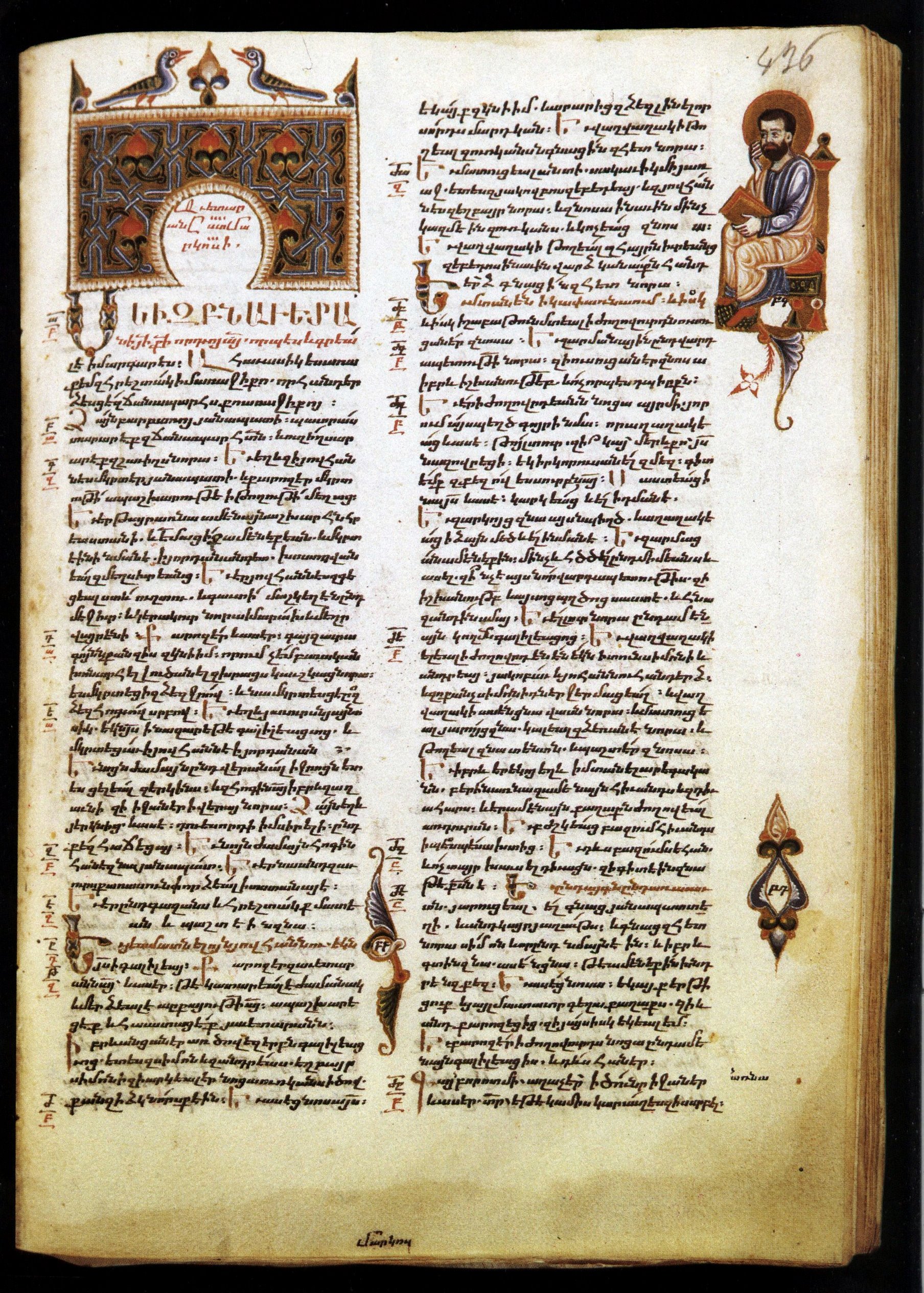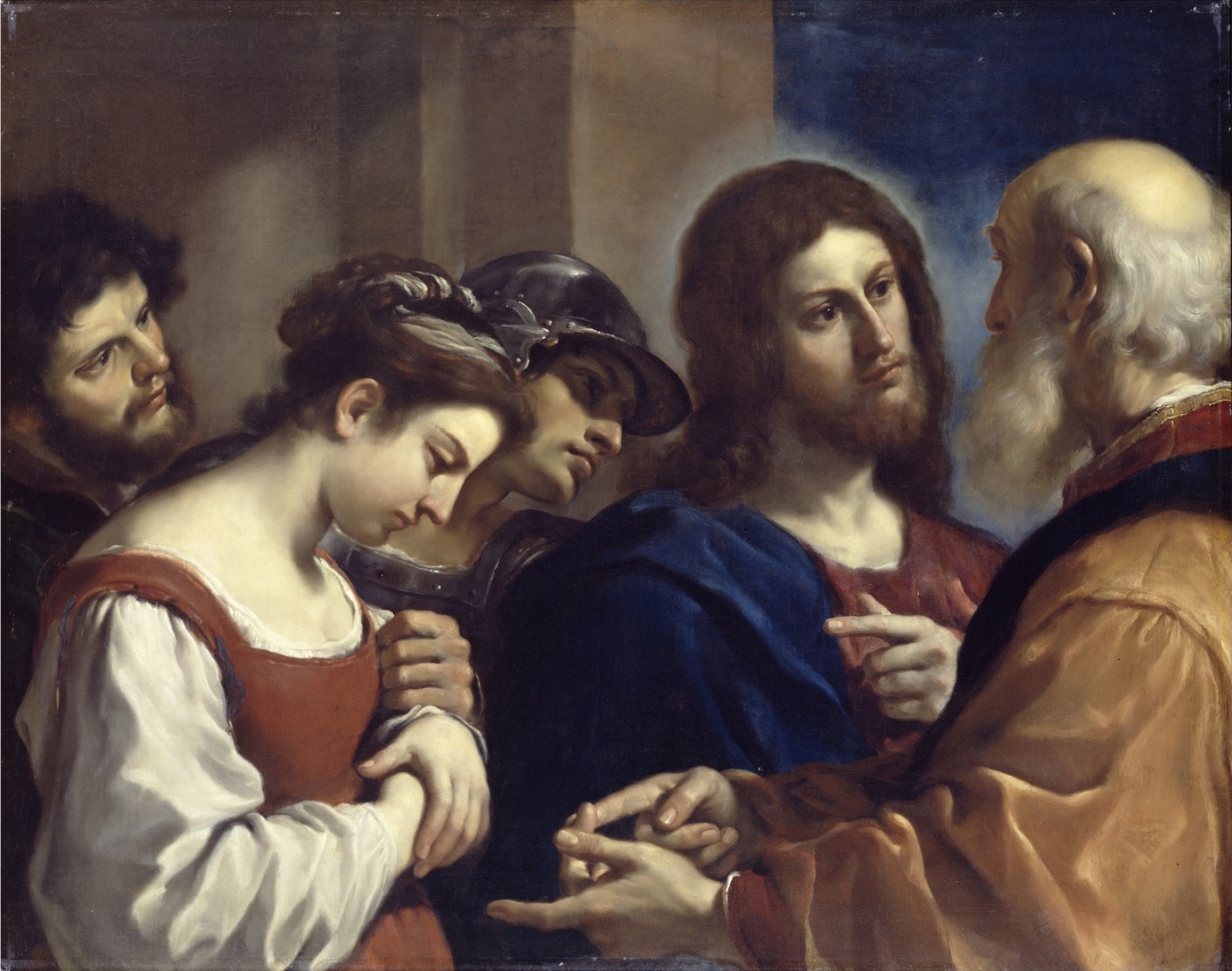|
Minuscule 897 (Gregory-Aland)
Minuscule 897 (in the Gregory-Aland numbering), ε 361 ( von Soden), is a 13th-century Greek minuscule manuscript of the New Testament on parchment. It has marginalia. The manuscript has not survived in complete condition. Description The codex contains the text of the four Gospels, on 327 parchment leaves (size ), with some lacunae. The text is written in one column per page, 17 lines per page. According to Hermann von Soden it has decorated headpieces and initials. It lacks texts of Matthew 1:1-7:6; 27:63-18:7; Luke 22:36-47; 23:45-24:1; John 8:8:33-10:24 (12:18-14:21). The text of the Gospels is divided according to the (''chapters''), whose numbers are given at the margin, and their (''titles of chapters'') at the top of the pages. There is also a division according to the smaller Ammonian Sections (in Mark 239 sections, the last section in Mark 16:20), whose numbers are given at the margin. There are no references to the Eusebian Canons. It contains lists of the ( ... [...More Info...] [...Related Items...] OR: [Wikipedia] [Google] [Baidu] |
Gospel
Gospel originally meant the Christian message (" the gospel"), but in the 2nd century it came to be used also for the books in which the message was set out. In this sense a gospel can be defined as a loose-knit, episodic narrative of the words and deeds of Jesus, culminating in his trial and death and concluding with various reports of his post-resurrection appearances. Modern scholars are cautious of relying on the gospels uncritically, but nevertheless, they provide a good idea of the public career of Jesus, and critical study can attempt to distinguish the original ideas of Jesus from those of the later authors. The four canonical gospels were probably written between AD 66 and 110. All four were anonymous (with the modern names added in the 2nd century), almost certainly none were by eyewitnesses, and all are the end-products of long oral and written transmission. Mark was the first to be written, using a variety of sources. The authors of Matthew and Luke both indepe ... [...More Info...] [...Related Items...] OR: [Wikipedia] [Google] [Baidu] |
Eusebian Canons
Eusebian canons, Eusebian sections or Eusebian apparatus, also known as Ammonian sections, are the system of dividing the four Gospels used between late Antiquity and the Middle Ages. The divisions into chapters and verses used in modern texts date only from the 13th and 16th centuries, respectively. The sections are indicated in the margin of nearly all Greek and Latin manuscripts of the Bible, and usually summarized in canon tables at the start of the Gospels. There are about 1165 sections: 355 for Matthew, 235 for Mark, 343 for Luke, and 232 for John; the numbers, however, vary slightly in different manuscripts. The canon tables were made to create a sense of divinity within the reader’s soul, to understand and reflect upon the various colors and patterns to achieve a higher connection with God. Authorship Until the 19th century it was mostly believed that these divisions were devised by Ammonius of Alexandria, at the beginning of the 3rd century ( 220), in connec ... [...More Info...] [...Related Items...] OR: [Wikipedia] [Google] [Baidu] |
Edinburgh
Edinburgh ( ; gd, Dùn Èideann ) is the capital city of Scotland and one of its 32 Council areas of Scotland, council areas. Historically part of the county of Midlothian (interchangeably Edinburghshire before 1921), it is located in Lothian on the southern shore of the Firth of Forth. Edinburgh is Scotland's List of towns and cities in Scotland by population, second-most populous city, after Glasgow, and the List of cities in the United Kingdom, seventh-most populous city in the United Kingdom. Recognised as the capital of Scotland since at least the 15th century, Edinburgh is the seat of the Scottish Government, the Scottish Parliament and the Courts of Scotland, highest courts in Scotland. The city's Holyrood Palace, Palace of Holyroodhouse is the official residence of the Monarchy of the United Kingdom, British monarchy in Scotland. The city has long been a centre of education, particularly in the fields of medicine, Scots law, Scottish law, literature, philosophy, the sc ... [...More Info...] [...Related Items...] OR: [Wikipedia] [Google] [Baidu] |
Carlo Maria Martini
Carlo Maria Martini (15 February 1927 – 31 August 2012) was an Italian Jesuit, cardinal of the Catholic Church and a Biblical scholar. He was Archbishop of Milan from 1980 to 2004 and was elevated to the cardinalate in 1983. A towering intellectual figure of the Roman Catholic Church, Martini was the liberal contender for the Papacy in the 2005 conclave, following the death of Pope John Paul II. According to highly placed Vatican sources, Martini received more votes in the first round than Cardinal Joseph Ratzinger, the conservative candidate: 40 to 38. Ratzinger ended up with more votes in subsequent rounds and was elected Pope Benedict XVI. Martini entered the Society of Jesus in 1944 and was ordained a priest in 1952. His appointment as Archbishop of Milan in 1980 was an unusual circumstance, as Jesuits are not traditionally named bishops. He was on the liberal wing of the church hierarchy. Suffering from a rare form of Parkinson's disease, he retired as archbishop in ... [...More Info...] [...Related Items...] OR: [Wikipedia] [Google] [Baidu] |
Novum Testamentum Graece
(''The New Testament in Greek'') is a critical edition of the New Testament in its original Koine Greek, forming the basis of most modern Bible translations and biblical criticism. It is also known as the Nestle–Aland edition after its most influential editors, Eberhard Nestle and Kurt Aland. The text, edited by the Institute for New Testament Textual Research, is currently in its 28th edition, abbreviated NA28. The title is sometimes applied to the United Bible Societies (UBS) edition, which contains the same text (its fifth edition, "UBS5", contains the text from NA28). The latter edition is aimed at translators and so focuses on variants that are important for the meaning whereas the NA includes more variants. The release of a 29th edition is expected in 2024. Methodology The Greek text as presented is what biblical scholars refer to as the "critical text". The critical text is an eclectic text compiled by a committee that compares readings from a large num ... [...More Info...] [...Related Items...] OR: [Wikipedia] [Google] [Baidu] |
George Bell & Sons
George Bell & Sons was a book publishing house located in London, United Kingdom, from 1839 to 1986. History George Bell & Sons was founded by George Bell as an educational bookseller, with the intention of selling the output of London university presses; but became best known as an independent publisher of classics and children's books. One of Bell's first investments in publishing was a series of ''Railway Companions''; that is, booklets of timetables and tourist guides. Within a year Bell's publishing business had outstripped his retail business, and he elected to move from his original offices into Fleet Street. There G. Bell & Sons branched into the publication of books on art, architecture, and archaeology, in addition to the classics for which the company was already known. Bell's reputation was only improved by his association with Henry Cole. In the mid-1850s, Bell expanded again, printing the children's books of Margaret Gatty (''Parables from Nature'') an ... [...More Info...] [...Related Items...] OR: [Wikipedia] [Google] [Baidu] |
A Plain Introduction To The Criticism Of The New Testament
''A Plain Introduction to the Criticism of the New Testament: For the Use of Biblical Students'' is one of the books of Frederick Henry Ambrose Scrivener (1813–1891), biblical scholar and textual critic. In this book Scrivener listed over 3,000 Greek manuscripts of the New Testament, as well as manuscripts of early versions. It was used by Gregory for further work. The book was published in four editions. The first edition, published in 1861, contained 506 pages. The second edition (1874) was expanded into 626 pages; the third into 751 pages; and the fourth into 874 pages. Two first editions were issued in one volume; in the third edition the material was divided into two volumes, with an increased number of chapters in each. The first volume was edited in 1883, the second in 1887. The fourth edition was also issued in two volumes (1894). The fourth edition of the book was reprinted in 2005 by Elibron Classics. First Edition The text of the first edition was divided i ... [...More Info...] [...Related Items...] OR: [Wikipedia] [Google] [Baidu] |
Institute For New Testament Textual Research
The Institute for New Testament Textual Research (german: Institut für neutestamentliche Textforschung — INTF) at the University of Münster, Westphalia, Germany, is to research the textual history of the New Testament and to reconstruct its Greek initial text on the basis of the entire manuscript tradition, the early translations and patristic citations; furthermore the preparation of an '' Editio Critica Maior'' based on the entire tradition of the New Testament in Greek manuscripts, early versions and New Testament quotations in ancient Christian literature. Under Kurt Aland's supervision, the INTF collected almost the entire material that was needed. The manuscript count in 1950 was 4250, in 1983, 5460, and in 2017 approximately 5800 manuscripts. Moreover, INTF produces several more editions and a variety of tools for New Testament scholarship, including the concise editions known as the "Nestle–Aland" – ''Novum Testamentum Graece'' and the UBS Greek New Testament. ... [...More Info...] [...Related Items...] OR: [Wikipedia] [Google] [Baidu] |
Jesus And The Woman Taken In Adultery
Jesus and the woman taken in adultery (or the ) is a passage (pericope) found in John 7:53– 8:11 of the New Testament. It has been the subject of much scholarly discussion. In the passage, Jesus was teaching in the Second Temple after coming from the Mount of Olives. A group of scribes and Pharisees confronts Jesus, interrupting his teaching. They bring in a woman, accusing her of committing adultery, claiming she was caught in the very act. They tell Jesus that the punishment for someone like her should be stoning, as prescribed by Mosaic Law. Jesus begins to write something on the ground using his finger; when the woman's accusers continue their challenge, he states that the one who is without sin is the one who should cast the first stone at her. The accusers and congregants depart, realizing not one of them is without sin either, leaving Jesus alone with the woman. Jesus asks the woman if anyone has condemned her and she answers no. Jesus says that he, too, does not ... [...More Info...] [...Related Items...] OR: [Wikipedia] [Google] [Baidu] |
Luke 1
Luke 1 is the first chapter of the Gospel of Luke in the New Testament of the Christian Bible. With 80 verses, it is one of the longest chapters in the New Testament. This chapter describes the birth of John the Baptist and the events leading up to the birth of Jesus.Halley, Henry H. ''Halley's Bible Handbook'': an Abbreviated Bible Commentary. 23rd edition. Zondervan Publishing House. 1962. Two canticles, the canticle of Mary (the Magnificat) and the canticle of Zechariah (the Benedictus) are both contained within this chapter. The unnamed author of Luke names its recipient, Theophilus, who is most likely a real (but unknown) person,Franklin, E., ''58. Luke'' in Barton, J. and Muddiman, J. (2001)The Oxford Bible Commentary pp. 926-7 but the term could simply mean a fellow believer, since ''theo'' ''philus'' is Greek for God lover. Early Christian tradition uniformly affirms that Luke composed this Gospel as well as the Acts of the Apostles,Holman Illustrated Bible Handbook. ... [...More Info...] [...Related Items...] OR: [Wikipedia] [Google] [Baidu] |
Claremont Profile Method
The Claremont Profile Method is a method for classifying ancient manuscripts of the Bible. It was elaborated by Ernest Cadman Colwell and his students. Professor Frederik Wisse attempted to establish an accurate and rapid procedure for the classification of the manuscript evidence of any ancient text with large manuscript attestation, and to present an adequate basis for the selection of balanced representatives of the whole tradition. The work of Wisse is limited only to three chapters in Luke: 1, 10, and 20. Wisse's profiles The word before the bracket is the reading of the UBS edition. The profile of a manuscript is formed by noting the numbers of those test readings where the manuscript agrees with the bold reading. The readings which are not bold are those of the Textus Receptus. Luke 1 * Luke 1:2 (1 reading) — ] * Luke 1:7 (2 reading) — ην η ελισαβετ ] η ελισαβετ ην * Luke 1:7 (3 reading) — η ] omit * Luke 1:8 (4 reading) — ] ενα ... [...More Info...] [...Related Items...] OR: [Wikipedia] [Google] [Baidu] |
William B
William is a masculine given name of Norman French origin.Hanks, Hardcastle and Hodges, ''Oxford Dictionary of First Names'', Oxford University Press, 2nd edition, , p. 276. It became very popular in the English language after the Norman conquest of England in 1066,All Things William"Meaning & Origin of the Name"/ref> and remained so throughout the Middle Ages and into the modern era. It is sometimes abbreviated "Wm." Shortened familiar versions in English include Will, Wills, Willy, Willie, Liam, Bill, and Billy. A common Irish form is Liam. Scottish diminutives include Wull, Willie or Wullie (as in Oor Wullie or the play ''Douglas''). Female forms are Willa, Willemina, Wilma and Wilhelmina. Etymology William is related to the German given name ''Wilhelm''. Both ultimately descend from Proto-Germanic ''*Wiljahelmaz'', with a direct cognate also in the Old Norse name ''Vilhjalmr'' and a West Germanic borrowing into Medieval Latin ''Willelmus''. The Proto-Germa ... [...More Info...] [...Related Items...] OR: [Wikipedia] [Google] [Baidu] |




